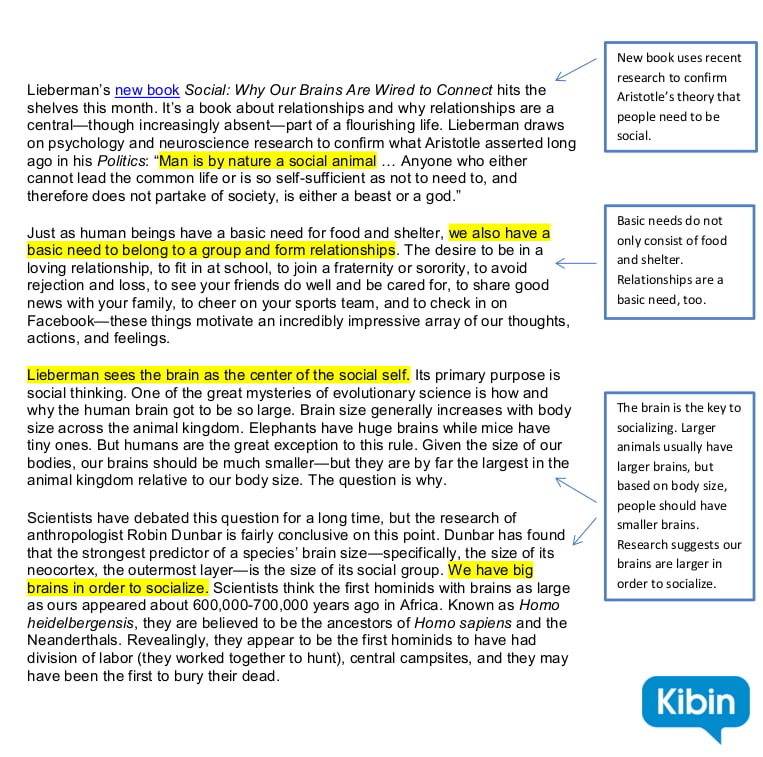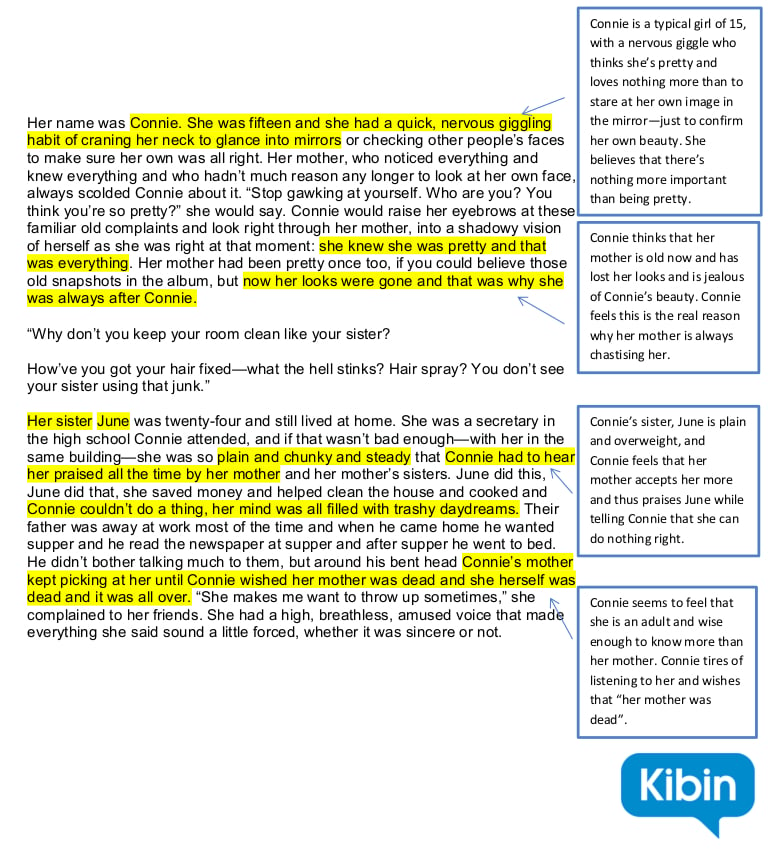I’m almost positive you’ve been given at least one assignment in your academic career that was nothing more than busy work.
You know the type: one that requires you to fill in the blanks by finding the correct word from a course reading or one that asks you to do nothing more than underline vocabulary words.
While this type of assignment keeps you busy for an hour or so, in the end, you walk away learning nothing (except how to waste time).
If you don’t know how to annotate a text properly and just start writing and highlighting for the sake of completing a task, annotation can be one of those great time-wasters.
If you know how to annotate a text correctly, though, annotation can be an amazing tool that will not only help you understand information but also be useful when researching.
Need a little convincing of the value of annotation? Here’s what you need to know in order to annotate a text properly.
What Is Annotation?

In the simplest of terms, annotation is another term for note-taking.
Most students are used to taking notes while listening to a lecture and jotting down a few notes when reading a course assignment.
Annotation, however, means that you’re more involved in the text itself.
You’re writing (or typing) directly on the document to help you remember (and better understand) important information.
Basic annotations can involve a variety of different strategies:
- Underlining, circling, or highlighting key terms or concepts.
- Asking questions. (These questions might be questions about concepts or arguments that you don’t understand, or questions about the topic itself.)
- Summarizing main ideas, arguments, or counterarguments.
If you’re a little more creative, you might find that drawing images, graphs, or charts can also help you visualize and remember key points.
While annotation can involve any or all of the strategies mentioned above, you don’t always have to use each strategy every time you annotate. How you annotate depends on your purpose for annotation.
Why Annotation Is Helpful
You may be thinking that all that circling, underlining, and writing of notes is more of a waste of time than anything. You might be thinking that you’d have lots more time to actually write your paper if you didn’t spend time annotating.
Yes and no. While it’s true that you may have more time to write your paper, it may not be as well-written as if you had annotated your sources.
And if you fail to annotate, you may end up taking a lot longer to write your paper than you might think.
Below are two reasons that annotation is helpful (and how it can actually save you time).
Annotation can help you understand (and therefore remember) information
If you read through something quickly, you tend to skip over words and miss key ideas. You might get to the end of an entire piece without really understanding what you’ve read.
If you annotate, however, you can note key points, summarize ideas, and ask questions. This interaction with the text forces you to slow down and think about what you just read.
Annotation can help you write a better research paper (and help you write it faster)
Though you might think that taking notes on all of your resources isn’t necessary and takes up too much time, it can actually be very beneficial and a time-saver.
When you read through sources, taking notes on the information helps you not only understand the information more completely, but also remember where the information is located.
Here’s a quick example. Let’s say you have seven journal articles as sources for your paper. If you’re using articles from professional journals, each article could easily range from 10-20 pages.
If you read the information but don’t annotate the articles, how will you remember where that perfect quote was? How will you remember what the key point of the article was that you wanted to include in your paper?
Annotation helps you keep track of the information you want to use in your paper. Then when it comes time to writing, you can locate it quickly and avoid wasting time searching through pages and pages of text.
How to Annotate a Text With Purpose
Many students only annotate when it’s a required course assignment. While this is certainly a good reason, there are other reasons you should annotate. For instance, you might annotate to understand content, respond to a prompt, or examine literary or rhetorical strategies.
Your purpose for annotating will inevitably change how and what you annotate, so understand your purpose before you begin reading AND have a goal in mind while you annotate.
Here are a few annotation strategies (based on your purpose for annotating):
- Annotate to understand the content and/or learn key vocabulary. Highlight thesis statements, summarize main ideas, and circle or highlight important terms. (Writing definitions in the margins can also be a useful way to remember more challenging terms.)
- Annotate to respond to a specific question or assignment prompt. If you’re asked to include personal reactions or relate the writing to your own life, look for those sections that you react to most strongly. If you’re asked to evaluate, analyze, or simply summarize, then you’ll annotate to answer the prompt. In other words, if you’re asked to analyze an argument, don’t simply include whether you agree or disagree—focus on analysis.
- Annotate to examine a text for literary or rhetorical strategies. While you may not be able to identify some literary or rhetorical strategies on the first read, it’s important that you keep them in mind and jot down points if you notice them. On your second and third reads, take note of the specific strategies you’re examining. If, for instance, your focus is character analysis, look for physical descriptions, comments, and actions that reveal character. If you’re looking for effectiveness of arguments, look for examples, statistics, and other evidence that supports the writer’s claims.
Example Annotations
Like the idea of annotating and think you can make it work for you but aren’t sure what actual annotations might look like? Here are two examples showing how to annotate a text for inspiration.
Example #1: Nonfiction annotations
Article excerpt from: Social Connection Makes a Better Brain by Emily Esfahani Smith
Purpose of annotation: To understand the content of the article. Annotations consist of highlighting key points and summarizing main ideas in the margins.
Take Note:
- Keep highlighted text to a minimum. Notice that in this example only a few key points are highlighted. Don’t go highlighter crazy just because you can. Huge numbers of highlighted sections just change the color of the text. If everything is highlighted, nothing stands out.
- Keep summaries brief. Notice that this example summarizes paragraphs in one or two sentences. Don’t paraphrase the entire paragraph. Hit only the key points. This will help you get the basics down and help you refresh your memory when you review the source again.
Download this nonfiction annotation as a PDF.
Example #2: Literary annotations
Short story excerpt from: Where Are You Going, Where Have You Been? by Joyce Carol Oates
Purpose of annotation: Character analysis. Annotations consist of a few key highlights and summarizing and analyzing the protagonist’s thoughts, feelings, and actions.
Take Note:
- Annotations should not only summarize but should also make connections. Remember, when analyzing literature, it’s not enough to simply identify information. You’re trying to figure out what it all means. In this sample annotation, comments examine Connie’s words and actions in an attempt to further understand her as a character.
Download this literary annotation as a PDF.
What to Do Once You’ve Annotated
Now that you’ve learned how to annotate a text properly and have a whole bunch of notes, what do you do next? Take those notes, and turn them into an essay!
Need help managing your time in the essay-writing process? Read How to Manage Time Better When Writing (and Living Your Life).
If you’re in need of a little help with the finer points of various types of essays, try reading some example essays that other students have written on the same topic. Here are a few posts that can also help you get on the right track:
- Six Popular Types of Essays: Your Survival Guide
- How to Write a Literary Analysis That Works
- How to Write a Research Paper: A Step-by-Step Guide
If you’re struggling with turning your annotations into a draft, let the experts at Kibin add a few annotations of their own to provide some useful writing and revising advice.




